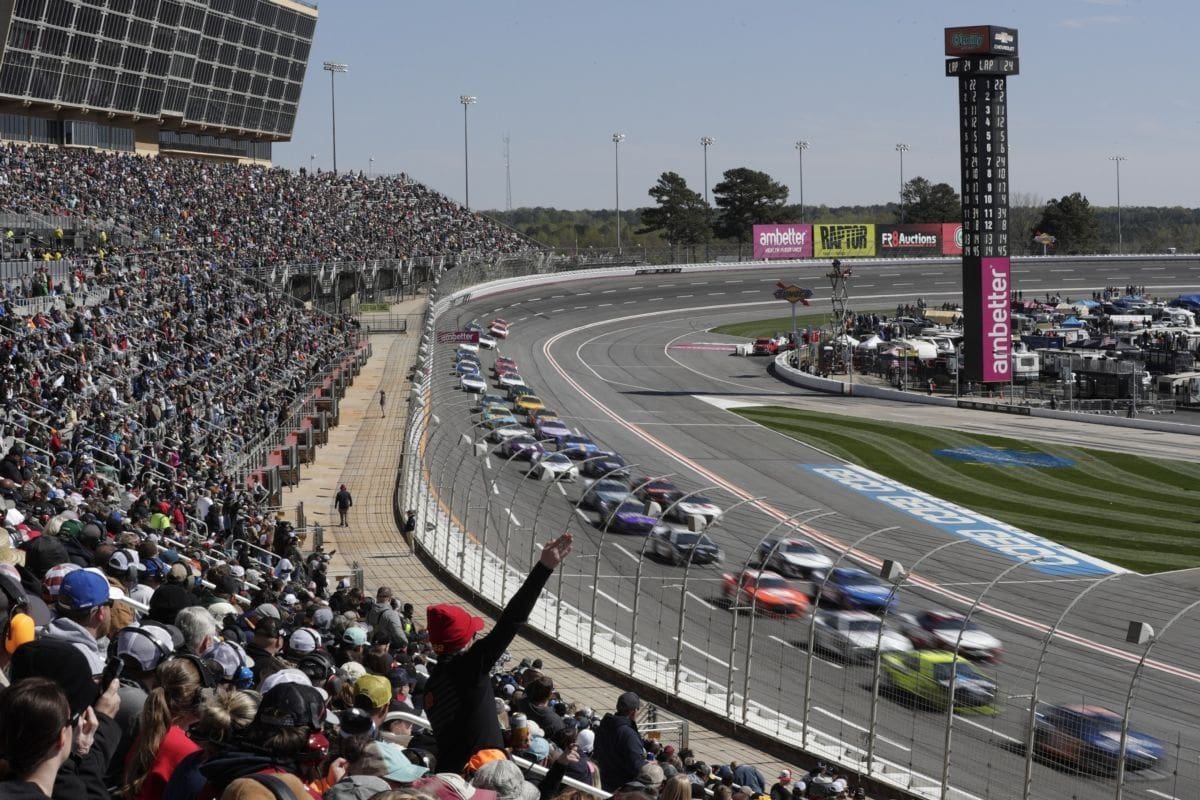Dale Jr. Slams NASCAR’s Atlanta Track Label: Dale Earnhardt Jr.‘s recent critique of NASCAR’s classification of Atlanta Motor Speedway as a “Superspeedway” has sparked a notable debate within the racing community. His assertion that the track’s 1.54-mile length and minimal banking changes do not align with the traditional characteristics of Superspeedways raises crucial questions about NASCAR’s branding and the implications for competitive racing. This controversy highlights potential inconsistencies in terminology and invites scrutiny of the underlying motivations for such a classification.
Key Highlights
- Dale Earnhardt Jr. argues that Atlanta Motor Speedway does not meet the traditional Superspeedway criteria due to its 1.54-mile length.
- NASCAR’s modifications to Cup cars do not create an authentic Superspeedway experience at Atlanta, according to Earnhardt.
- The unique characteristics of Daytona and Talladega cannot be replicated at Atlanta, challenging its classification.
- Earnhardt emphasizes the importance of maintaining strict terminology to preserve the integrity of racing classifications.
- The emergence of “drafting tracks” as a term adds confusion, misleading comparisons with true Superspeedways like Daytona and Talladega.
Atlanta Motor Speedway’s Overhaul and Superspeedway Status
Transforming the Atlanta Motor Speedway into a modern racing venue has sparked considerable debate regarding its classification as a Superspeedway. The notable overhaul, which took place prior to the 2022 season, involved increasing the banking in the turns from 24 to 28 degrees and widening the front stretch. These modifications were intended to improve competitive edge and promote side-by-side racing, a hallmark of thrilling motorsport.
However, the question remains: does this transformation genuinely merit the designation of a Superspeedway? Traditionally, a Superspeedway is defined by its length—typically over two miles—and its capacity for high-speed racing. While Atlanta’s new configuration does enhance corner handling for modern stock cars, the track measures only 1.5 miles in length. The incremental increase in banking, while beneficial, may not suffice to raise its status alongside iconic tracks like Daytona and Talladega.
NASCAR veteran Dale Earnhardt Jr. has voiced skepticism, challenging the racing community‘s rush to categorize Atlanta as a Superspeedway. His perspective highlights a broader concern about the potential dilution of the Superspeedway classification, which has historically been reserved for tracks that meet specific criteria.
The Argument Against Atlanta as a Superspeedway
The debate surrounding Atlanta Motor Speedway‘s classification as a Superspeedway hinges on the fundamental criteria that define such tracks. Traditionally, Superspeedways are characterized by their long lengths—typically over two miles—and wide, high-banked turns designed to facilitate high-speed racing. Atlanta, however, measures only 1.54 miles, which raises questions about its legitimacy within this category, despite NASCAR’s recent reconfiguration efforts.
NASCAR’s decision to modify the Cup cars for Superspeedway racing in 2022, employing 7-inch spoilers and 510-horsepower engines, aligns Atlanta with Daytona and Talladega concerning vehicle specifications. Nonetheless, this mechanical alignment does not necessarily equate to a true Superspeedway experience.
Dale Earnhardt Jr. articulates this sentiment, emphasizing that the unique characteristics of tracks like Daytona and Talladega cannot be replicated at Atlanta. The essence of Superspeedway racing encompasses a distinct dynamic, heavily influenced by track length and configuration, elements that Atlanta inherently lacks.
“I don’t think you put it (Atlanta) in Daytona and Talladega category. It isn’t the same. NASCAR and NBC would love to say they are on the same track.”
“What I really get annoyed with is how those terms like a short track, intermediate, one-mile oval, that’s pretty straightforward, superspeedway, those were terms that adhered strictly to a size. They are not just loose terms.” – jr
Moreover, the implementation of modified tapered spacers to restrict horsepower at Atlanta further complicates its classification. While NASCAR may argue that such adjustments justify its Superspeedway status, they contradict the very principles that define competitive racing on longer tracks.
Consequently, the rationale behind designating Atlanta as a Superspeedway appears more as a marketing strategy than a reflection of its racing pedigree. Hence, the argument against Atlanta’s classification is rooted in both its physical dimensions and the intrinsic nature of Superspeedway racing, prompting ongoing discussions within the NASCAR community.
Dale Earnhardt Jr.’s Definition of Superspeedways
Dale Earnhardt Jr. provides a critical perspective on the definition of Superspeedways, arguing that the term should be strictly associated with specific track dimensions rather than being applied loosely to venues like Atlanta Motor Speedway.
He emphasizes the significance of maintaining precise terminology in motorsports to foster clear communication and understanding among teams, drivers, and fans similarly. For Earnhardt, the classifications of racetracks are not arbitrary but rather serve to delineate the unique characteristics that define each type.
“It’s not a Superspeedway. Superspeedway is anything 2 miles and larger. You could consider Michigan a Superspeedway, but I wouldn’t. But definitely, Talladega and Daytona are superspeedways; the rest of the tracks are simply speedways. – jr
Earnhardt delineates track classifications into clear categories: short tracks, which are under one mile; intermediate tracks, ranging from one to two miles; and superspeedways, defined as those exceeding two miles in length.
He points to iconic tracks like Daytona and Talladega, which measure 2.5 miles and 2.66 miles, respectively, as quintessential examples of superspeedways. This strict adherence to dimensional criteria is crucial, he argues, in preserving the integrity of racing classifications.
Atlanta’s Race Package and Its Classification Debate
A growing controversy surrounds the classification of Atlanta Motor Speedway, particularly in view of its unique race package that blurs the lines between traditional definitions of track types.
Dale Earnhardt Jr. has voiced strong dissent against labeling Atlanta as a superspeedway, emphasizing that true superspeedways, like Daytona and Talladega, are characterized by a length of two miles or more. His assertion highlights an essential distinction: merely adopting the same race package as these iconic tracks does not suffice for classification.
Atlanta Motorspeedway operates with a race package that includes a 510-horsepower engine and a 7-inch rear spoiler, similar to the configurations used at Daytona and Talladega. In contrast, the standard package for most tracks—termed as speedways—features a higher horsepower of 670 and a 4-inch spoiler.
This disparity raises questions about the integrity of Atlanta’s classification, as it combines a speedway length with superspeedway specifications, resulting in a hybrid identity that challenges traditional nomenclature.
The current situation suggests a potential need for a new classification that accurately reflects this unique blend. As the debate unfolds, it is vital for NASCAR and its stakeholders to reflect on how such classifications impact competitive dynamics and fan perceptions.
The New Term “Drafting Tracks” and Dale Jr.’s Opinion
Confusion surrounding the classification of racing tracks has led to the emergence of the term “drafting tracks,” a label that Dale Earnhardt Jr. critiques for its ambiguity. This term has gained traction primarily in reference to NASCAR’s Atlanta Superspeedway, but Earnhardt argues that the essence of drafting occurs on all speedways. He contends that the introduction of this term stems from a need for analysts to categorize the new dynamics of racing in Atlanta, which some perceive as a departure from traditional mile-and-a-half tracks.
“There was never a term called this is a drafting track. Like it’s a new term right? That was coined by. I want to put it on the racing insights guys. They had no other way to describe the new Atlanta. The stat guys wanted to say, we need to give stats, if you are an announcer, we need to give you stats on who’s good at these types of races. But this isn’t an intermediate, this isn’t a mile-and-a-half cookie cutter anymore. It’s kind of like Daytona, Talladega, it’s a drafting track so we are gonna call it a drafting track.” – jr
Earnhardt believes that the term “drafting tracks” muddles the understanding of racing statistics, as drivers’ performances are increasingly compared to those at Daytona and Talladega, leading to misleading inferences.
“It’s so annoying because now that’s like a new term and now there’s this new statistics been compiled around drivers that are winning races and running well at drafting tracks.” – jr
News in Brief: Dale Jr. Slams NASCAR’s Atlanta Track Label
The classification of Atlanta Motor Speedway as a “Superspeedway” has sparked considerable debate within the NASCAR community. Critics, including Dale Earnhardt Jr., assert that this designation undermines the integrity of racing classifications, potentially misleading fans and teams. As discussions regarding track terminology and competitive dynamics evolve, the introduction of terms like “Drafting Tracks” may provide clarity. Ultimately, NASCAR’s marketing strategy must balance tradition with innovation to maintain credibility and cohesion within the sport.
ALSO READ: Dale Earnhardt Jr. Challenges NFL: Bold Stance on NASCAR’s $7.7 Billion Move



